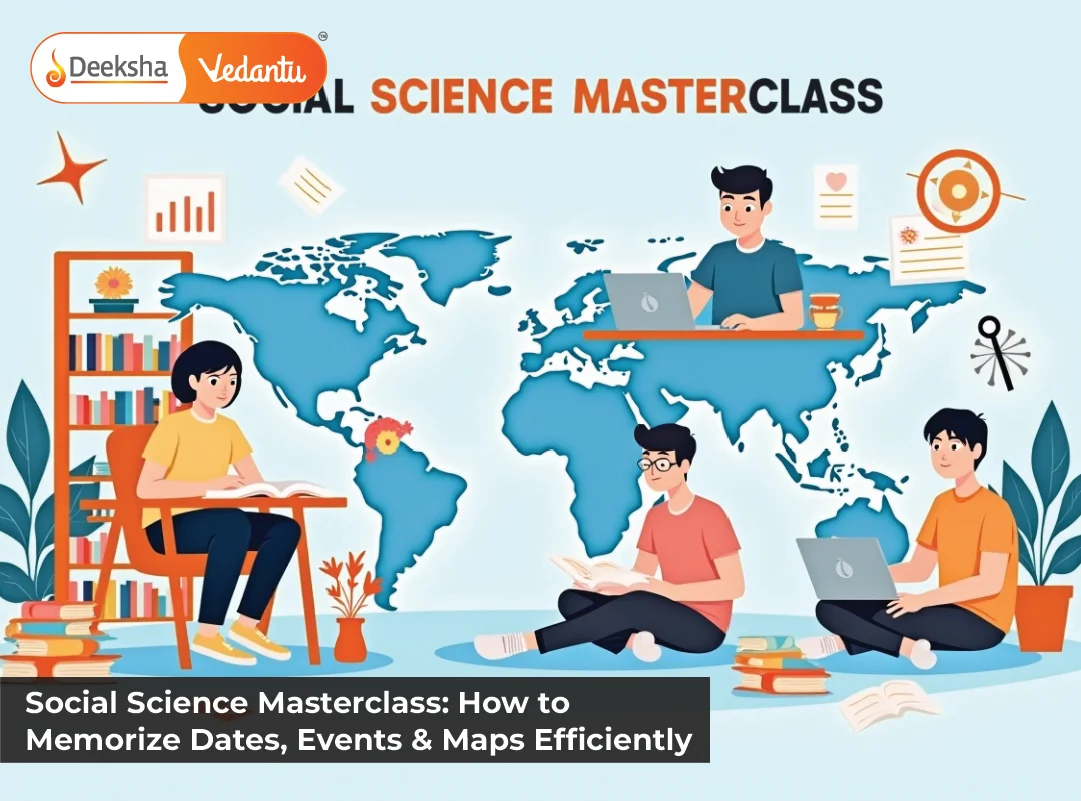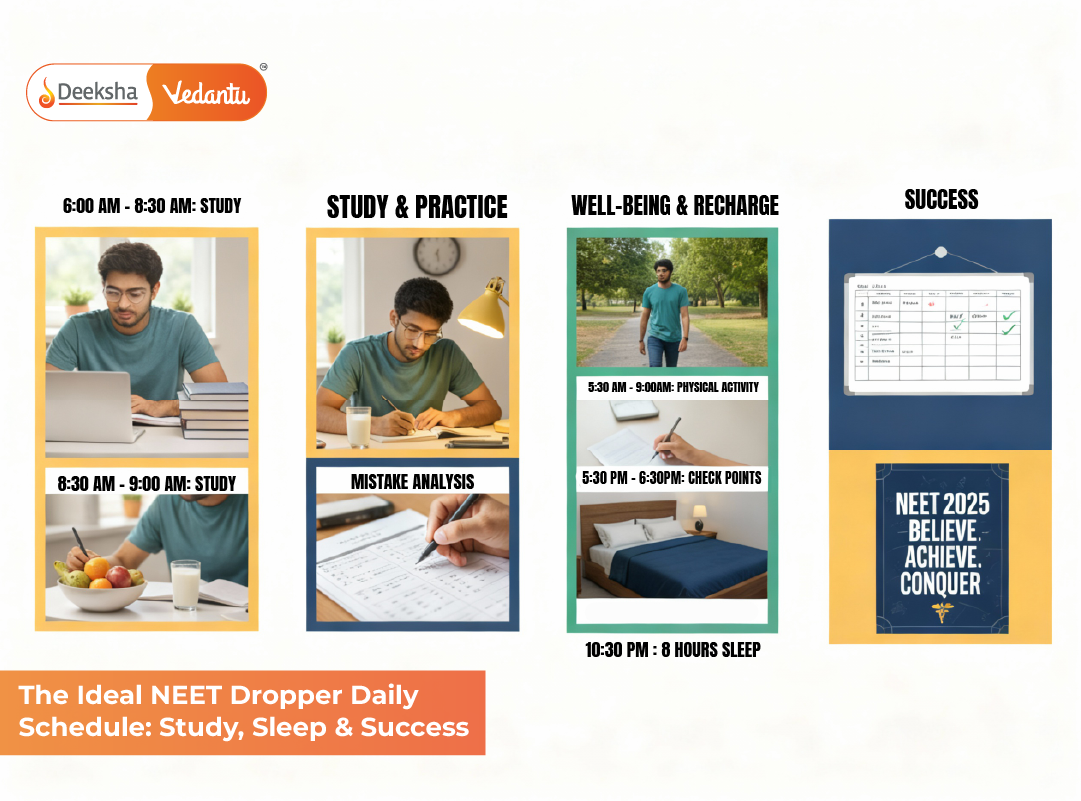Introduction
Social Science can seem overwhelming to many students due to the vast amount of information it covers, particularly when it comes to memorizing dates, historical events, and maps. However, mastering these aspects is essential for scoring well in the SSLC 2025 exams. With the right techniques and consistent practice, you can make memorization easy, efficient, and even fun.
In this blog, we’ll discuss proven strategies to help you memorize dates, events, and maps effectively, ensuring that you retain important information for the long term and perform confidently during the exam. At Deeksha Vedantu, we guide students through structured and focused learning techniques that turn challenging memorization tasks into manageable ones, so they can excel in Social Science with ease.
Why Memorization is Crucial in Social Science
Social Science in SSLC includes history, geography, civics, and economics, all of which require the ability to remember large amounts of information. Here’s why memorizing dates, events, and maps is vital:
1. Importance of Dates, Events, and Maps in SSLC Social Science
Dates and events form the backbone of history, while maps are essential for understanding geographical concepts. These elements are often tested in both theory-based and practical exam sections. Memorizing them allows you to answer questions accurately and demonstrates a clear understanding of key concepts.
2. How Memorization Enhances Understanding and Recall
While memorization may seem like a simple task, it actually helps improve your understanding of the subject. By linking dates and events in history or places on a map to specific events or geographic features, you’ll build a deeper connection to the material. This approach enhances both your recall and ability to explain concepts clearly during the exam.
3. The Impact of Memorization on Time Management During Exams
Efficient memorization not only helps you retain information but also saves time during exams. When you’ve memorized key dates, events, and map locations, you won’t waste time trying to recall or locate them during the test. This allows you to answer questions quickly and efficiently, ensuring that you complete your paper on time.
Effective Techniques for Memorizing Dates and Historical Events
Memorizing dates and historical events can feel daunting, but using the right techniques can make the process much easier and more efficient. Here are some tried-and-true methods that will help you retain historical facts for the SSLC 2025 exam:
1. Create Timelines
Timelines are one of the best ways to visualize historical events and their connections. Create a visual timeline for each chapter, marking the key events in chronological order. This will help you see the flow of history and make it easier to remember the sequence of events.
- Tip: Use color coding for different periods or events to further enhance memory retention. For example, use one color for wars, another for political events, and so on.
2. Break Events into Smaller, Manageable Chunks
Rather than trying to memorize entire eras or long lists of dates, break them down into smaller, more manageable sections. For example, instead of memorizing the entire history of the Indian independence movement in one go, focus on key movements or events, such as the Non-Cooperation Movement, Quit India Movement, or the Salt March.
- Tip: Group related events together to make it easier to remember them. For example, if you’re studying the timeline of World War II, remember events in terms of the battles or treaties that were part of the war, rather than just trying to memorize dates and facts in isolation.
3. Use Mnemonics for Complex Dates
Mnemonics are powerful tools to help you memorize difficult dates or events. Create a memorable phrase, acronym, or story that links to the historical event or date you’re trying to remember. For instance, for a date like 1857 (Indian Rebellion), you might come up with a mnemonic such as “In 1857, India’s revolt began,” to make it easier to recall the year.
- Tip: The more creative and unique the mnemonic, the better it will stick in your memory. Use funny or unusual images to make the association even stronger.
4. Make Use of Flashcards
Flashcards are a great way to practice quick recall. Write the date on one side of the flashcard and a brief description of the event or its significance on the other. Review these flashcards regularly, testing yourself to reinforce your memory.
- Tip: Organize flashcards by themes or periods (e.g., ancient, medieval, modern) to make studying more organized.
5. Link Events with Real-Life Context
Sometimes, it’s easier to remember historical events when you relate them to something that’s already familiar. For instance, link a historical event to a current event, or find similarities between a person or event in history and something you’ve personally experienced or know.
- Tip: Visualize the event. For instance, if you’re studying the Industrial Revolution, imagine the working conditions in factories as described in history books and connect them to similar conditions today. This will help you retain the information longer.
Tips for Memorizing Maps Efficiently
Maps are an essential part of the Social Science syllabus, and memorizing them efficiently is key to performing well in the SSLC 2025 exams. Whether it’s locating countries, rivers, mountains, or capitals, here are some effective techniques to help you memorize maps efficiently:
1. Break Maps into Smaller Sections
Instead of trying to memorize the entire map in one go, break it down into smaller regions or landmarks. Focus on one part of the map at a time — for instance, memorizing the locations of major rivers in one study session, and then shifting to neighboring countries or mountain ranges in another.
- Tip: Practice by dividing the map into quadrants or use a grid system to learn one section at a time.
2. Use Color Coding for Easy Identification
Color coding is a powerful tool for memorization. Highlight different regions, countries, rivers, or mountains in different colors to make them stand out. This technique allows you to easily distinguish between different parts of the map and helps retain information longer.
- Tip: Use colored pens or highlighters to mark areas like countries, capitals, mountain ranges, and rivers. This way, you can quickly identify and recall important details during revision.
3. Practice with Blank Maps
One of the best ways to reinforce map memorization is by practicing with blank maps. Regularly test yourself by filling in maps with the locations of key features such as countries, capitals, rivers, and mountains.
- Tip: Use practice tests from past papers, online resources, or blank maps from your textbook. Time yourself to build speed and accuracy.
4. Label Maps with Key Information
Once you’ve drawn a map or filled in a blank map, label all the important geographical features. For example, label rivers, mountain ranges, borders, and capitals. Ensure that each label is clear, and use a ruler for straight lines to keep the map tidy.
- Tip: Don’t just rely on textbooks — try labeling maps from memory and then check for accuracy. This will strengthen recall.
5. Use Online Tools and Apps for Map Practice
Interactive tools and apps can make map memorization more engaging. Many online platforms offer interactive maps where you can quiz yourself on the location of countries, capitals, and geographical features.
- Tip: Use apps or websites like Seterra or Sheppard Software, which provide fun, interactive quizzes to test your map knowledge and reinforce learning.
Common Mistakes to Avoid While Memorizing Social Science Content
When it comes to memorizing dates, events, and maps for Social Science, there are a few common mistakes that can hinder your progress. Recognizing and avoiding these errors will help you improve your retention and efficiency. Here are the most common mistakes and how to avoid them:
1. Memorizing Without Understanding the Context
Simply memorizing dates or events without understanding the underlying context can make it difficult to recall information during the exam. Without context, facts are just isolated pieces of information, which can lead to confusion.
- Tip: Always make sure you understand the significance of an event or date. Relate it to other historical events or real-life examples to enhance your understanding. At Deeksha Vedantu, we emphasize not just memorization, but also contextual learning to help students gain a deeper understanding.
2. Relying on Passive Reading Instead of Active Recall
Many students fall into the trap of reading the textbook passively, expecting the information to stick. Passive reading doesn’t engage your memory enough to retain the details long term.
- Tip: Use active recall methods, such as practicing with flashcards or writing summaries, to test your knowledge. Engage with the content by asking yourself questions and attempting to answer them from memory.
3. Neglecting to Practice Maps and Their Details
Maps often get overlooked in favor of dates and events, but they are equally important in the SSLC exam. Neglecting map practice can lead to mistakes or lack of confidence when answering map-related questions.
- Tip: Practice regularly with blank maps and quizzes to reinforce your memory of geographical locations, capitals, and important landmarks.
4. Rushing Through Historical Events Without Reviewing Key Dates
It’s common to focus on understanding historical events but forget to review the key dates associated with those events. This can lead to confusion when trying to recall the correct timeline.
- Tip: Keep a separate list of key dates and events that you can review frequently. Consider using flashcards or timelines to reinforce the dates in a visual format.
5. Not Revising Regularly
Cramming information at the last minute can lead to forgetting important dates, facts, or locations. Regular revision is essential for solidifying your memory.
- Tip: Set aside time each day to revise previously learned content. Consistent, spaced-out revision strengthens memory and helps prevent the forgetting curve.
FAQs
1. How can I memorize historical dates and events effectively?
Use techniques like creating timelines, breaking events into smaller sections, and associating dates with real-life context or mnemonics. Flashcards are also helpful for quick recall during revision.
2. What is the best way to study maps for SSLC exams?
Practice regularly with blank maps, color-code key regions, and use online tools or apps to quiz yourself. Break the map into smaller sections and focus on learning one area at a time for better retention.
3. How can I avoid forgetting dates during the exam?
Review your timeline and key events frequently, and use active recall techniques. Mnemonics and visual aids like color-coded timelines will make it easier to retain difficult dates.
4. How much time should I dedicate to memorizing Social Science content?
Ideally, spend 30–45 minutes a day focusing on memorizing dates, events, and maps. Break your study sessions into shorter, manageable intervals to avoid feeling overwhelmed.
5. How can I improve my retention of Social Science content?
Engage in active learning methods like flashcards, quizzes, and group discussions. Regularly revise what you’ve learned, and focus on understanding the material rather than rote memorization.
Conclusion
Memorizing dates, events, and maps for Social Science might seem like a daunting task, but with the right techniques and consistent practice, it can become an achievable and even enjoyable part of your SSLC 2025 preparation. By breaking down complex information into smaller sections, using visual aids, and practicing active recall, you’ll find yourself mastering these key elements with ease.
Stay focused, practice consistently, and believe in your ability to succeed. With the right techniques, you’ll be well on your way to acing the Social Science paper and securing top marks in the SSLC exams.
Table of Contents










Get Social